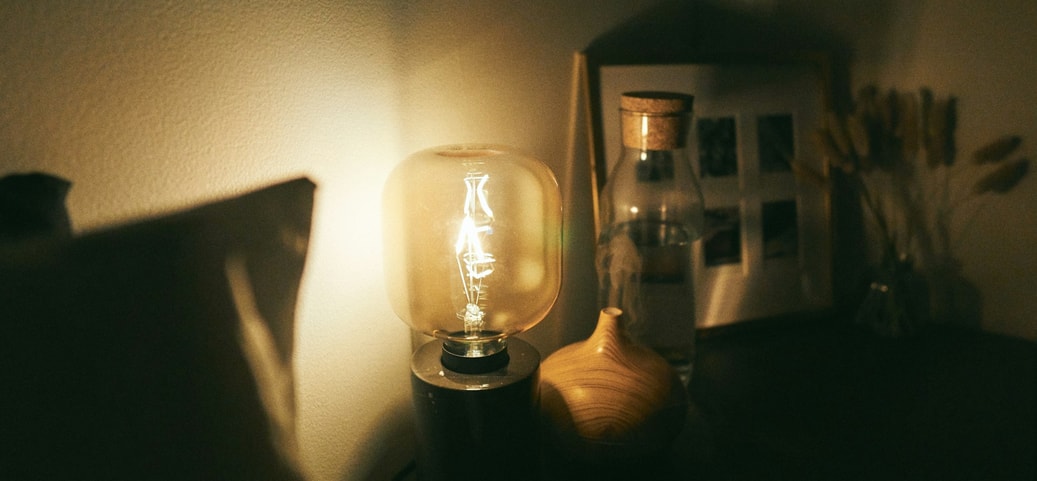Sleeping with the light on? Why you better not turn on your night light!
Do you remember that during a certain phase of your childhood, you could only sleep with a sleeping light? Perhaps you have remembered that time because of sleep problems. And now you’re probably thinking that sleeping with the light on could still help you fall asleep and stay asleep today. Here, you find out why you shouldn’t try this experiment.
by CALIDA
October 16, 2024•3 min reading time

A warm lamp gently illuminates the room.
Table of Contents
Why you should sleep in the dark: The thing with melatonin
You have probably heard of the sleep hormone melatonin. When it gets dark in the evening, your body starts to produce less of the stress hormones that keep you awake, such as cortisol and adrenaline, and instead more of the sleep-regulating melatonin that makes you tired. Many people who suffer from sleep disorders therefore need to supplement this hormone.
Darkness is therefore the best way to fall asleep in the evening. There are also some foods that contain melatonin, such as cranberries, some types of mushrooms and cereals or dried tomatoes and peppers. However, even these foods can’t replace the effect of turning off the lights.
Is light harmful to health when sleeping?
Researchers have discovered that people are even sensible to small light sources during sleep. People are more likely to suffer from cardiovascular disease, diabetes or obesity if they look at their cell phones at night or sleep with a night light on.
However, the exact cause is not yet known. It’s possible that the light at night leads to a generally poorer quality of sleep. The metabolism, which normally runs at full speed during sleep, would be impaired. This in turn could increase the risk of the mentioned diseases.
It’s also possible that sick people wake up more frequently and switch on the light due to pain, the urge to urinate or restlessness. The exact connection between sleeping with the light on and the development of certain diseases therefore needs to be researched further. One thing is certain, however: Light disturbs sleep and can make it extremely difficult to fall asleep and to stay asleep.

Different types of light & their effects on sleep
Another important finding that scientists have been able to make is that not all light is the same. Thousands of years ago, people slept by the fire to protect themselves from wild animals. This red or amber-coloured light affects melatonin production significantly less than artificial light sources, which are used by the vast majority of people today.
So, if you wake up at night and need some light for a short time, it’s better to switch to candlelight or, for safety reasons, to red light lamps. They are even said to be able to stimulate melatonin production. If you have the opportunity, you can also turn on the fireplace a few hours before going to sleep and switch off other light sources instead. This also prepares you optimally for a restful sleep.
White & blue screen light is particularly harmful at night
Many people look at their cell phones in bed – to set an alarm clock, for example, or to check their emails and social media. However, anyone who is already sleeping badly should definitely refrain from doing this, as the blue light from TV and smartphone displays massively disrupts melatonin production.
What’s more, the content you consume on TV or your cell phone often triggers strong emotions, causing you to release both stress and happiness hormones – neither of which you need in the evening.
So, if you suffer from sleep problems, set you alarm clock as early as possible and don’t touch your cell phone in bed. Instead of watching an upsetting TV program, you can turn to an exciting book, keep a diary, do some meditation or simply do nothing at all. Also, a red light lamp is a good investment for your bedside table.
Light to fall asleep: What to do if children don’t want to sleep in the dark?
Many children demand a night light because they are afraid of the dark. This phenomenon is particularly common between the ages of 2 and 4 and parents naturally want to allay their fears by installing a sleep light or leaving the door open.
Nevertheless, the same applies to children as to adults: Even a small source of light can disturb sleep – especially for those who sleep less well anyway. To reduce anxiety in the dark, you can leave the door ajar to fall asleep. Even slightly open curtains or blinds usually allow enough light into the room to give your child a sense of security.
However, the light in your child’s room should not be on all night. Instead, you could install a red night light that reacts to loud noises such as crying or shouting. This way, you take away your child’s fear of the dark without them having to sleep with light on all night.
Discover more interesting blog posts:


